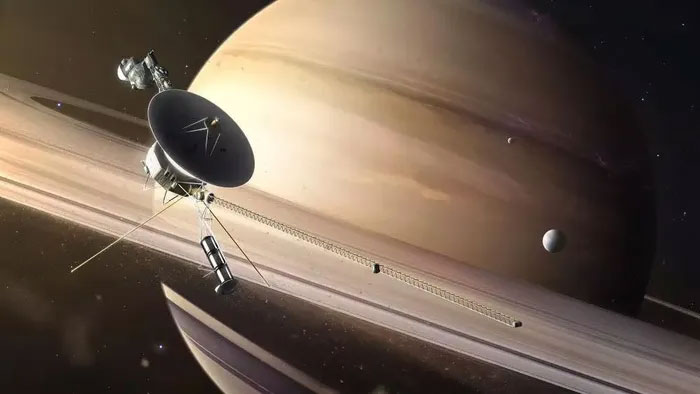How was a spacecraft 25 billion kilometers from Earth 'resurrected'?
The Voyager 1 interstellar spacecraft has had to resort to using an old radio transmitter to contact NASA after experiencing a signal failure.
In October, NASA lost contact with the Voyager 1 spacecraft due to a problem with its transmitter. The disruption began on October 16, when NASA transmitted a command to the spacecraft asking it to turn on one of its heaters. However, the spacecraft's electronics did not respond to the command from Earth.

Voyager 1 lost signal with NASA in October. (Photo: NASA).
In fact, it took NASA about two days to realize the problem. That's because Voyager 1 is the most distant man-made object ever launched into space, nearly 25 billion kilometers from Earth, and it takes about 23 hours for a message to reach the spacecraft. Then it takes another 23 hours for experts to receive a response.
By October 18, Voyager 1 had missed its scheduled return call to mission control. NASA's Deep Space Network (DSN) scanned the signal and eventually found it on a different frequency band.
According to preliminary findings, the heater automatically triggered Voyager 1's built-in fault protection system . If one device uses too much power, this mechanism automatically shuts down other unnecessary systems to save energy.
In this case , the X-band radio transmitter , the spacecraft's main communication link to Earth, was the faulty device . To save power, the protection system reduced the data transmission rate and changed the X-band signal.
The DSN re-established the connection and everything was stable while the NASA team investigated the problem. But the next day, communication was completely lost again.

Voyager 1 could lose contact with NASA completely by 2036. (Photo: NASA).
NASA suspects that Voyager 1's X-band transmitter triggered a protection system, forcing the spacecraft to switch to the less power-hungry S-band transmitter. This was the first time the S-band had been used since 1981.
Fortunately, DSN engineers successfully reconnected and confirmed that the device was still operational on October 22. However, the engineering team has not yet reactivated the X-band to continue investigating the cause of the problem, in the hope of restoring Voyager 1 operations soon.
The Voyager probes, nearly 50 years old in technology, continue to operate despite numerous technical problems as they venture deep into interstellar space. Currently, two Voyager probes are exploring the region of space beyond the influence of the Sun.
The dwindling power supply will cause Voyager 1 and 2 to stop collecting data after 2025 and lose contact completely in 2036 when they exceed the operating range of the DSN.
Nevertheless, they continued their journey for thousands of years to come, carrying humanity's messages to unknown civilizations in the vast universe.
- NASA's fight to save a spacecraft 24 billion kilometers away
- Earth looks from a distance of more than 40 million kilometers out of space
- How to get us to another star system 40,000 billion kilometers from Stephen Hawking Earth
- The American spacecraft exits the solar system
- NASA sends images to Earth from a distance of 7 billion km
- NASA's $ 3.3 billion spacecraft is about to commit suicide on Saturn
- Ancient water 4.6 billion years hidden thousands of kilometers underground
- Asteroids '' ride 'asteroids for 30 minutes
- NASA shuts down plasma device to save spacecraft 20.5 billion kilometers away
- Chinese spacecraft flew over the planet Toutatis
- The mysterious spacecraft X-37B has returned to Earth
- The 'missing' Soviet spacecraft 50 years is about to fall to Earth?
 Van Allen's belt and evidence that the Apollo 11 mission to the Moon was myth
Van Allen's belt and evidence that the Apollo 11 mission to the Moon was myth The levels of civilization in the universe (Kardashev scale)
The levels of civilization in the universe (Kardashev scale) Today Mars, the sun and the Earth are aligned
Today Mars, the sun and the Earth are aligned The Amazon owner announced a secret plan to build a space base for thousands of people
The Amazon owner announced a secret plan to build a space base for thousands of people